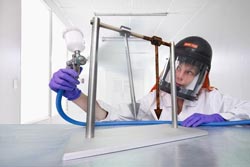Grease-free bonded coating with incorporated corrosion protection

The new bonded coating is grease-free and also protects against corrosion<br>Source: Uwe Bellhäuser <br>
The INM will be exhibiting these and other developments from 23 to 24 October at Eurofinish 2013 in Ghent (Belgium).
Machine parts such as gear wheels, screw threads, cranks and bicycle chains wear if there is friction between their metal surfaces; lubricants and functional oils help prevent this. These grease-based lubricants combine with dirt, abrasion and dust, and over time form lumps or become resinous.
Machine parts then have to be expensively cleaned and regreased, which means more frequent maintenance, greater consumption of resources, polluting waste and at times machine breakdowns. Researchers at the INM have now developed a bonded coating which is grease-free and also protects against corrosion.
“The thing about our bonded coating is its composition and structure”, explains Carsten Becker-Willinger, Head of the Nanomers Program Division. “We have incorporated platelet-like solid lubricants and platelet-like particles in a binder. When this mixture is applied to a surface, it produces a well-ordered structure in which these various particles are arranged in a roof tile pattern”, he adds. This forms a so-called transfer film between the bonded coating and the object through which surfaces can slide with the minimum of friction. “The particular mixture ratio means that our composite has a very low coefficient of friction. If we only used a solid lubricant, the coefficient of friction would be considerably higher”, says the chemist.
The roof tile structure not only provides low-friction sliding, it also acts as a barrier. This is a particular advantage because as a result the material also prevents moisture or salts penetrating metal surfaces, thus also protecting against corrosion. In a neutral salt spray context, the composite has a corrosion resistance of over 1000 hours on low-alloy steel.
The bonded coating can be applied using classic wet chemistry processes such as spraying or dipping. The roof tile structure forms by simple thermal curing without any further assistance in self-organization.
Contact:
Dr Carsten Becker-Willinger
INM – Leibniz Institute for New Materials
Spokesman Chemical Nanotechnology
Head Program Division Nanomere
Phone: +49681-9300-196
nanomere@inm-gmbh.de
INM conducts research and development to create new materials – for today, tomorrow and beyond. Chemists, physicists, biologists, materials scientists and engineers team up to focus on these essential questions: Which material properties are new, how can they be investigated and how can they be tailored for industrial applications in the future? Four research thrusts determine the current developments at INM: New materials for energy application, new concepts for implant surfaces, new surfaces for tribological applications and nanosafety/nanobio interaction. Research at INM is performed in three fields: Chemical Nanotechnology, Interface Materials, and Materials in Biology.
INM – Leibniz Institute for New Materials, situated in Saarbruecken, is an internationally leading centre for materials research. It is an institute of the Leibniz Association and has about 190 employees.
Media Contact
All latest news from the category: Trade Fair News
Newest articles

Silicon Carbide Innovation Alliance to drive industrial-scale semiconductor work
Known for its ability to withstand extreme environments and high voltages, silicon carbide (SiC) is a semiconducting material made up of silicon and carbon atoms arranged into crystals that is…

New SPECT/CT technique shows impressive biomarker identification
…offers increased access for prostate cancer patients. A novel SPECT/CT acquisition method can accurately detect radiopharmaceutical biodistribution in a convenient manner for prostate cancer patients, opening the door for more…

How 3D printers can give robots a soft touch
Soft skin coverings and touch sensors have emerged as a promising feature for robots that are both safer and more intuitive for human interaction, but they are expensive and difficult…





















